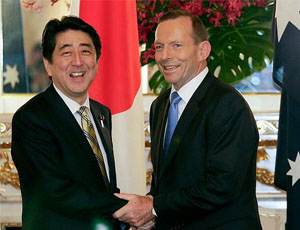 Australia and Japan have signed a landmark free trade agreement (FTA) in Canberra this week that will bring significant economic benefits to exporters in both countries.
Australia and Japan have signed a landmark free trade agreement (FTA) in Canberra this week that will bring significant economic benefits to exporters in both countries.
The Japan-Australia Economic Partnership Agreement (JAEPA), which was finalized earlier this year after seven years of negotiations, was signed by Australian Prime Minister Abbott and Japanese Prime Minister Abe during Abe’s three-day visit of Australia, the first official visit by a Japanese leader since 2002.
Once JAEPA is fully implemented, more than 97 percent of Australia’s exports to Japan will enter duty-free or receive preferential access, making it the most liberalizing FTA ever signed by Japan.
“This agreement will give Australian exporters better access to the US$5 trillion Japanese market than Japan has provided under any other of its trade agreements. It is particularly encouraging to see Japan’s commitment, for the first time in any trade agreement, to provide Australian financial services companies guaranteed cross-border access in a number of areas, including the provision of investment advice and portfolio management services,” said Jennifer Westacott, Chief Executive of the Business Council of Australia.
Highlights of the agreement include the reduction of tariffs on Japanese electronics, major appliances and cars, which will make Japanese cars up to US$1400 cheaper in Australia. Japan will cut tariffs on all of Australia’s current minerals, energy and manufacturing exports and reduce tariffs on Australian fresh beef to 23.5 percent over 15 years and frozen beef to 19.5 percent over 18 years, giving an estimated US$5.15 billion boost to the beef industry over 20 years.
RELATED: China, Japan and South Korea Enter Fourth Round of FTA Talks
Although JAEPA has been hailed for being the most liberalizing FTA ever signed by Japan, the terms are much more modest than those proposed by the U.S. for Japan, Australia and the ten other countries currently in negotiations regarding the Trans-Pacific Partnership (TPP). The TPP, which is on its way to becoming the largest and most ambitious free trade agreement in the world, aims to eventually eliminate all tariffs on all goods.
Despite having made notable progress last year, negotiations for the TPP have recently reached an impasse due to a deadlock between Japan and the U.S. regarding Japan’s ultra-sensitive agricultural import duties. Both Japan and Australia hope that JAEPA will help to drive progress in the TPP talks by pressuring the U.S. to agree to similar terms with Japan as Australia.
JAEPA is Australia’s second bilateral FTA with a major economic power in Northeast Asia following the signature of an FTA between Australia and South Korea in April. An Australia-China FTA is currently under negotiation and is expected to be finalized by the end of the year. China, Japan and South Korea are Australia’s largest, second largest and third largest export markets respectively and together these countries represent over half of Australia’s exports.
Australia and Japan have highly complementary economies and Japan was Australia’s biggest trading partner for more than four decades. Trade between the two countries amounted to US$66.5 billion in 2013, more than 10 percent of Australia’s overall trade.
Asia Briefing Ltd. is a subsidiary of Dezan Shira & Associates. Dezan Shira is a specialist foreign direct investment practice, providing corporate establishment, business advisory, tax advisory and compliance, accounting, payroll, due diligence and financial review services to multinationals investing in China, Hong Kong, India, Vietnam, Singapore and the rest of ASEAN. For further information, please email asia@dezshira.com or visit www.dezshira.com.
Stay up to date with the latest business and investment trends in Asia by subscribing to our complimentary update service featuring news, commentary and regulatory insight.
Related Reading
 An Introduction to Tax Treaties Throughout Asia
An Introduction to Tax Treaties Throughout Asia
In this issue of Asia Briefing Magazine, we take a look at the various types of trade and tax treaties that exist between Asian nations. These include bilateral investment treaties, double tax treaties and free trade agreements – all of which directly affect businesses operating in Asia.
 An Introduction to Development Zones Across Asia
An Introduction to Development Zones Across Asia
In this issue of Asia Briefing Magazine, we break down the various types of development zones available in China, India and Vietnam specifically, as well as their key characteristics and leading advantages. We then go on to provide a snapshot of the latest development zones across the rest of Asia. With several hundred development zones operating in the region, it is impossible to cover them all in the pages of just one publication. However, we hope that this issue will provide the basic fundamentals to understanding one of the most important business tools available to international businesses operating in Asia.


